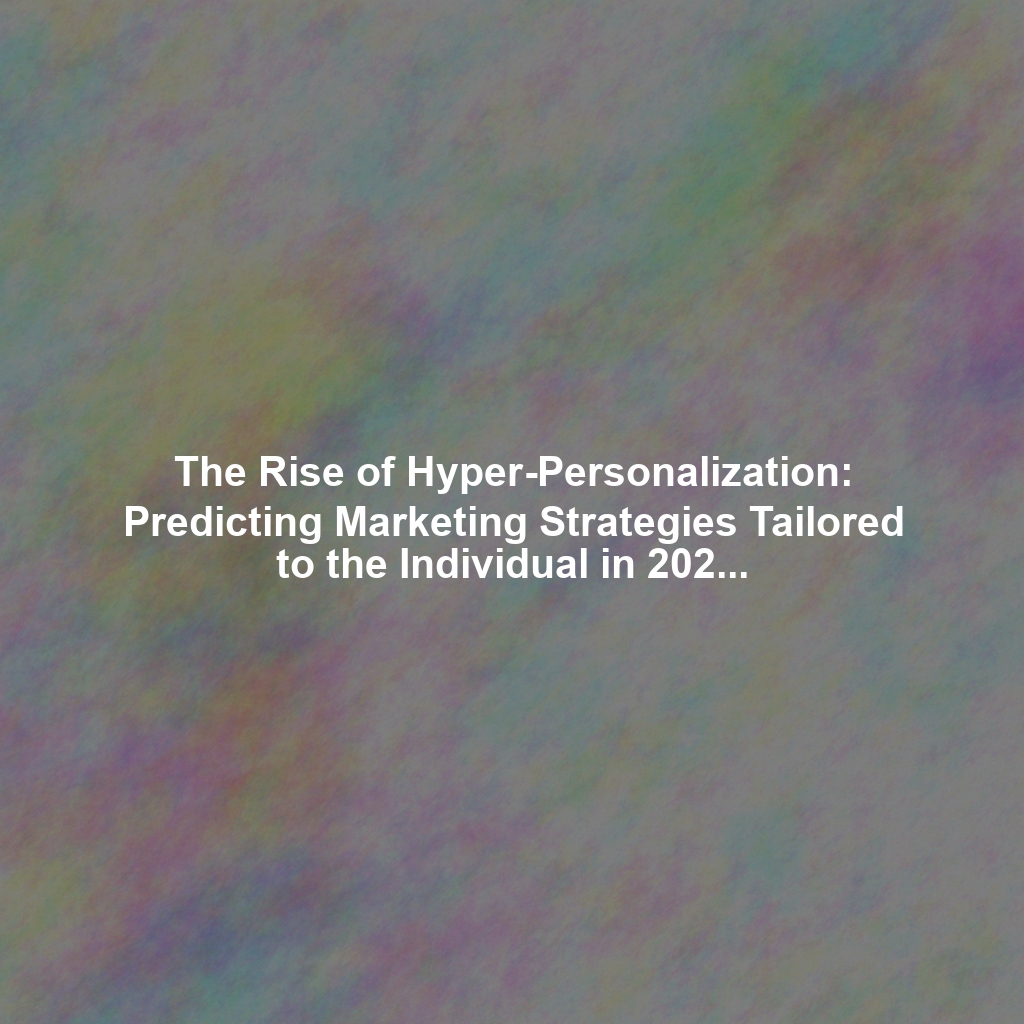The marketing landscape is in constant flux, but 2024 promises a shift of tectonic proportions: the widespread adoption of AI-powered hyper-personalization. We’re moving beyond simply knowing a customer’s name in an email; we’re talking about predicting their needs before they even realize them themselves. This article explores how advancements in Artificial Intelligence (AI) and machine learning (ML) are enabling marketers to anticipate individual customer desires and proactively deliver incredibly personalized experiences across all touchpoints. We’ll delve into the technologies making this possible, examine the ethical implications, and consider practical applications, including real-world examples and potential pitfalls to avoid.
The Engines of Prediction: AI Technologies Driving Hyper-Personalization
Several key technologies are converging to make predictive marketing a reality. These aren’t just buzzwords; they are sophisticated tools that are rapidly becoming essential for competitive advantage.
Machine Learning: Unveiling Patterns in the Data Deluge
Machine learning algorithms are the workhorses of hyper-personalization. They analyze vast quantities of data – purchase history, browsing behavior, social media activity, even sentiment analysis of customer reviews – to identify patterns and predict future behavior. Think of it as a super-powered version of “customers who bought this item also bought…” But instead of simply recommending related products, machine learning can predict when a customer is likely to need a refill of their favorite coffee, suggest a specific vacation package based on past travel patterns and current weather conditions in their city, or even proactively offer a discount on a product they’ve been eyeing for weeks.
Behavioral Analytics: Understanding the “Why” Behind the “What”
While machine learning identifies patterns, behavioral analytics delves deeper into why customers behave the way they do. It tracks user interactions with websites, apps, and marketing materials to understand their intent and motivations. For example, if a customer repeatedly visits a specific product page but doesn’t make a purchase, behavioral analytics can flag this as a potential opportunity. Perhaps they need more information, are hesitant about the price, or are simply comparison shopping. This insight allows marketers to tailor their messaging and offers to address the customer’s specific concerns and nudge them towards conversion.
Predictive Modeling: Foreseeing Future Actions
Predictive modeling uses statistical techniques and machine learning algorithms to forecast future customer behavior with a high degree of accuracy. This goes beyond simple segmentation. It’s about creating individual profiles and anticipating actions such as:
- Churn Prediction: Identifying customers at risk of leaving and proactively offering incentives to retain them.
- Purchase Propensity: Determining the likelihood that a customer will buy a specific product or service.
- Lifetime Value Prediction: Estimating the total revenue a customer will generate over their relationship with the company.
By leveraging these predictive models, marketers can allocate their resources more effectively, focusing on high-potential customers and tailoring their interactions to maximize engagement and revenue.
Practical Applications: Hyper-Personalization in Action
The potential applications of AI-powered hyper-personalization are virtually limitless. Here are a few examples of how companies are already leveraging this technology to drive results:
- E-commerce: Personalized product recommendations, dynamic pricing based on individual customer behavior, and targeted promotions based on browsing history.
- Financial Services: Proactive fraud detection, personalized investment advice, and tailored loan offers based on individual financial profiles.
- Healthcare: Personalized treatment plans, proactive health alerts based on wearable data, and tailored medication reminders.
- Content Marketing: Delivering the right content to the right person at the right time, based on their interests and browsing history.
Example: Netflix utilizes sophisticated algorithms to predict what users will enjoy watching based on their viewing history, ratings, and search behavior. This leads to highly personalized recommendations, keeping users engaged and subscribed.
Ethical Considerations: Navigating the Dark Side of Prediction
While the potential benefits of hyper-personalization are undeniable, it’s crucial to address the ethical implications. Concerns about privacy, data security, and algorithmic bias must be carefully considered.
Transparency and Consent
Customers need to understand how their data is being collected, used, and shared. Clear and concise privacy policies are essential, and companies must obtain explicit consent before using personal data for hyper-personalization purposes. This includes giving customers the option to opt-out of data collection and personalized experiences.
Algorithmic Bias
Machine learning algorithms are trained on data, and if that data is biased, the algorithms will perpetuate and even amplify those biases. This can lead to unfair or discriminatory outcomes. For example, a loan application algorithm trained on historical data that reflects past biases against certain demographic groups might unfairly deny loans to individuals from those groups. Companies must actively work to mitigate algorithmic bias by carefully auditing their data and algorithms.
Data Security and Privacy
With great power comes great responsibility. Companies that collect and use personal data have a responsibility to protect that data from unauthorized access and misuse. Robust security measures, data encryption, and compliance with privacy regulations such as GDPR are essential.
Potential Pitfalls to Avoid
Implementing AI-powered hyper-personalization is not without its challenges. Here are some potential pitfalls to watch out for:
- Over-personalization: Creeping out customers with overly personalized experiences. There’s a fine line between helpful and intrusive.
- Data Silos: Failing to integrate data from different sources, resulting in incomplete and inaccurate customer profiles.
- Lack of Expertise: Underestimating the technical expertise required to implement and manage AI-powered personalization systems.
- Ignoring Human Input: Relying too heavily on algorithms and neglecting the importance of human judgment and creativity.
Conclusion: Embracing the Future of Marketing
AI-powered hyper-personalization is poised to revolutionize marketing in 2024 and beyond. By leveraging machine learning, behavioral analytics, and predictive modeling, marketers can anticipate customer needs, deliver truly personalized experiences, and build stronger, more lasting relationships. However, it’s crucial to approach this technology responsibly, addressing the ethical implications and avoiding common pitfalls. Those who embrace this technology strategically and ethically will be well-positioned to thrive in the increasingly competitive marketing landscape of the future. The era of mass marketing is fading; the age of hyper-personalization has arrived.



Leave a Reply